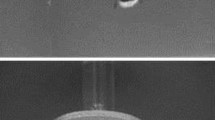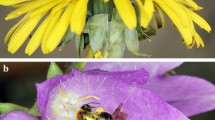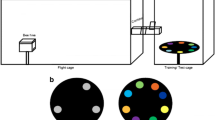Abstract
Large carpenter bees are charismatic and ubiquitous flower visitors in the tropics and sub-tropics. Unlike honeybees and bumblebees that have been popular subjects of extensive studies on their neuroethology, behaviour and ecology, carpenter bees have received little attention. This review integrates what is known about their foraging behaviour as well as sensory, physiological and cognitive adaptations and is motivated by their versatility as flower visitors and pollinators. This is evident from their extremely generalist foraging and adeptness at handling diverse flower types as legitimate pollinators and as illegitimate nectar robbers. They purportedly use traplining to forage between isolated patches and are long-distance flyers over several kilometres suggesting well-developed spatial learning, route memory and navigational capabilities. They have a broad range of temperature tolerance and thermoregulatory capabilities which are likely employed in their forays into crepuscular and nocturnal time periods. Such temporal extensions into dim-light periods invoke a suite of visual adaptations in their apposition optics. Thus, we propose that carpenter bees are an excellent though understudied group for exploring the complex nature of plant-pollinator mutualisms from ecological and mechanistic perspectives.





Similar content being viewed by others
References
Ackerman JD, Mesler MR, Lu KL, Montalvo AM (1982) Food-foraging behavior of male Euglossini (Hymenoptera: Apidae): vagabonds or trapliners? Biotropica 14:241–248
Anzenberger G (1977) Ethological study of African carpenter bees of the genus Xylocopa (Hymenoptera, Anthophoridae). Z Tierpsychol 44:337–374. https://doi.org/10.1111/j.1439-0310.1977.tb01001.x
Balter M (2012) Why are our brains so big? Science 338:33–34
Banschbach VS, Waddington KD (1994) Risk-sensitive foraging in honey bees: no consensus among individuals and no effect of colony honey stores. Anim Behav 47:933–941
Ben Y, Cohen R, Gerling D, Moscovitz E (1978) The biology of Xylocopa pubescens Spinola (Hymenoptera: Anthophoridae) in Israel. Isr J Entomol 12:107–121
Bernardino AS, Gaglianone MC (2008) Nest distribution and nesting habits of Xylocopa ordinaria Smith (Hymenoptera, Apidae) in a restinga area in the northern Rio de Janeiro State, Brazil. Rev Bras Entomol 52:434–440
Berry RP, Wcislo WT, Warrant EJ (2011) Ocellar adaptations for dim light vision in a nocturnal bee. J Exp Biol 214:1283–1293. https://doi.org/10.1242/jeb.050427
Bohart GE, Youssef NN (1976) The biology and behavior of Evylaeus galpinsiae Cockerell (Hymenoptera: Halictidae). Wasmann J Biol 34:185–234
Bonelli B (1974) Osservazioni etoecologiche sugli Imenotteri aculeati dell’Etiopia. VII. Xylocopa (Mesotrichia) combusta Smith (Hymenoptera–Anthophoridae) Boll Ist Ent. Univ Bol 32:105–132
Buatois A, Lihoreau M (2016) Evidence of trapline foraging in honeybees. J Exp Biol 219:2426–2429
Buchmann SL (1983) Buzz pollination in angiosperms. In: Jones CE, Little RJ (eds) Handbook of experimental pollination biology. Van Nostrand-Rheinhold, New York, pp 73–113
Burgett DM, Sukumalanand P (2000) Flight activity of Xylocopa (Nyctomelitta) tranquebarica: a night flying carpenter bee (Hymenoptera: Apidae). J Apic Res 39:75–83
Burkart A, Schlindwein C, Lunau K (2014) Assessment of pollen reward and pollen availability in Solanum stramoniifolium and Solanum paniculatum for buzz-pollinating carpenter bees. Plant Biol 16:503–507. https://doi.org/10.1111/plb.12111
Byrne R, Whiten A (1989) Machiavellian intelligence: social expertise and the evolution of intellect in monkeys, apes, and humans. Oxford Science Publications, Oxford
Camillo E, Garófalo CA (1982) On the bionomics of Xylocopa frontalis (Olivier) and Xylocopa grisescens. (Lepeletier) in Southern Brazil. I. Nest construction and biological cycle. Rev Bras Biol 42:571–582
Camillo E. Garófalo CA, Muccillo G (1986) On the bionomics of Xylocopa suspecta (Moure) in Southern Brazil: Nest construction and biological cycle (Hymenoptera, Anthophoridae). Rev Bras Biol 46:383–393
Chappell MA (1982) Temperature regulation of carpenter bees (Xylocopa californica) foraging in the Colorado Desert of southern California. Physiol Zool 55:267–280
Chittka L, Thomson JD, Waser NM (1999) Flower constancy, insect psychology, and plant evolution. Naturwissenschaften 86(7):361–367. https://doi.org/10.1007/s001140050636
Corbet SA, Willmer PG (1980) Pollination of the yellow passionfruit: nectar, pollen and carpenter bees. J Agric Sci 95:655–666. https://doi.org/10.1017/S0021859600088055 doi
Dedej S, Delaplane KS (2004) Nectar-robbing carpenter bees reduce seed-setting capability of honey bees (Hymenoptera: Apidae) in rabbiteye blueberry, Vaccinium ashei, ‘Climax’. Environ Entomol 33:100–106. https://doi.org/10.1603/0046-225X-33.1.100
di Tanah Bencah KPB (2012) The importance of carpenter bee, Xylocopa varipuncta (Hymenoptera: Apidae) as pollination agent for mangrove community of Setiu wetland, Terengganu. Sains Malays 41:1057–1062
Dorchin A, Filin I, Izhaki I, Dafni A (2012) Movement patterns of solitary bees in a threatened fragmented habitat. Apidologie 44:90–99
Dujardin F (1850) Mémoire sur le système nerveux des insectes. Ann Sci Nat Zool 14::195–206
Dukas R, Real LA (1991) Learning foraging tasks by bees: a comparison between social and solitary species. Anim Behav 42:269–276. https://doi.org/10.1016/S0003-3472(05)80558-5
Dunbar RIM (1998) The social brain hypothesis. Evol Anthropol Issues News Rev 6:178–190. https://doi.org/10.1002/(SICI)1520-6505(1998)
Dunbar RIM, Shultz S (2007) Evolution in the social brain. Science 317:1344 LP–L1347
Dyer FC (1985) Nocturnal orientation by the Asian honeybee, Apis dorsata. Anim Behav 33:769–774
Eisikowitch D (1987) Calotropis procera Ait. (Asclepiadaceae) and Xylocopa spp.: a study of inter-relationships. In: Insect-Plants Proc 6th Inter Symp Insect-Plants Relat PAU (1986), pp 341–345
Faegri K, van der Pijl L (1979) Principles of pollination ecology. Pergamon Press, Oxford
Frankie GW, Vinson SB (1977) Scent marking of passion flowers in Texas by females of Xylocopa virginica texana (Hymenoptera: Anthophoridae). J Kansas Entomol Soc 50:613–625
Frederiksen R, Wcislo WT, Warrant EJ (2008) Visual reliability and information rate in the retina of a nocturnal bee. Curr Biol 18:349–353
Gerling D, Hermann HR (1978) Biology and mating behavior of Xylocopa virginica L. (Hymenoptera, Anthophoridae). Behav Ecol Sociobiol 3:99–111. https://doi.org/10.1007/BF00294984
Gerling D, Hurd PD Jr, Hefetz A (1983) Comparative behavioral biology of two Middle East species of carpenter bees (Xylocopa latreille) (Hymenoptera: Apoidea). Smithson Contrib Zool 193:315–324. https://doi.org/10.5479/si.00810282.369
Gerling D, Velthuis HHW, Hefet A (1989) Bionomics of the large carpenter bees of the genus Xylocopa. Annu Rev Entomol 34:163–190. https://doi.org/10.1146/annurev.ento.34.1.163
Gottlieb D, Keasar T, Shmida A, Motro U (2005) Possible foraging benefits of bimodal daily activity in Proxylocopa olivieri (Lepeletier) (Hymenoptera: Anthophoridae). Environ Entomol 34:417–424. https://doi.org/10.1603/0046-225X-34.2.417
Goulson D (1999) Foraging strategies of insects for gathering nectar and pollen, and implications for plant ecology and evolution. Perspect Plant Ecol Evol Syst 2:185–209. https://doi.org/10.1078/1433-8319-00070
Goulson D, Stout JC (2001) Homing ability of the bumblebee Bombus terrestris (Hymenoptera: Apidae). Apidologie 32:105–111
Greenleaf SS, Williams NM, Winfree R, Kremen C (2007) Bee foraging ranges and their relationship to body size. Oecologia 153:589–596. https://doi.org/10.1007/s00442-007-0752-9
Greiner B, Ribi WA, Warrant EJ (2004a) Retinal and optical adaptations for nocturnal vision in the halictid bee Megalopta genalis. Cell Tissue Res 316:377–390
Greiner B, Ribi WA, Wcislo WT, Warrant EJ (2004b) Neural organisation in the first optic ganglion of the nocturnal bee Megalopta genalis. Cell Tissue Res 318:429–437
Gronenberg W, Riveros AJ (2009) Social brains and behavior: past and present. In: Jadau J, Fewell J (eds) Organisation of insect societies: From genome to sociocomplexity. Harvard University Press, Cambridge
Heinrich B, Buchmann SL (1986) Thermoregulatory physiology of the carpenter bee, Xylocopa varipuncta. J Comp Physiol B 156:557–562. https://doi.org/10.1007/BF00691042
Heinrich B, Esch H (1994) Thermoregulation in bees. Am Sci 82:164–170
Hogendoorn K, Leys R (1993) The superseded female’s dilemma: ultimate and proximate factors that influence guarding behaviour of the carpenter bee Xylocopa pubescens. Behav Ecol Sociobiol 33:371–381. https://doi.org/10.1007/BF00170252
Hogendoorn K, Velthuis HHW (1999) Task allocation and reproductive skew in social mass provisioning carpenter bees in relation to age and size. Insectes Soc 46:198–207. https://doi.org/10.1007/s000400050135
Hogendoorn K, Steen Z, Schwarz MP (2000) Native Australian carpenter bees as a potential alternative to introducing bumble bees for tomato pollination in greenhouses. J Apic Res 39:67–74. https://doi.org/10.1080/00218839.2000.11101023
Hopkins MJG, Hopkins HCF, Sothers CA (2000) Nocturnal pollination of Parkia velutina by Megalopta bees in Amazonia and its possible significance in the evolution of chiropterophily. J Trop Ecol 16:733–746
Hurd PD (1955) The carpenter bees of California (Hymenoptera: Apoidea). University of California Press, Berkeley
Hurd Paul DJR, Moure JSCMF (1960) A new-world subgenus of bamboo-nesting carpenter bees belonging to the genus Xylocopa latreille (Hymenoptera: Apoidea). Ann Entomol Soc Am 53:809–821
Inouye DW (1980) The terminology of floral larceny. Ecology 61:1251–1253
Inouye DW (1983) The ecology of nectar robbing. In: Bentley B, Illas T (eds) The biology of nectaries. Columbia Univ Press, New York
Iwata K (1976) Evolution of instinct: comparative ethology of hymenoptera. Amerind Publishing Company, New Delhi, India
Jacobson E (1927) Fauna sumatrensis: Xylocopinae, biologie. Suppl Entomol 1 6:93–103
Janzen DH (1964) Notes on the behavior of four subspecies of the carpenter bee, Xylocopa (Notoxylocopa) tabaniformis, in Mexico. Ann Entomol Soc Am 57:296–301
Jolly A (1966) Lemur social behavior and primate intelligence. Science 153:501–506
Kapil RP, Dhaliwal JS (1969) Biology of Xylocopa species. II. Field activities, flight range and trials on transportation of nests. Punjab Agric Univ J Res 6:262–271
Keasar T (2010) Large carpenter bees as agricultural pollinators. Psyche. https://doi.org/10.1155/2010/927463 (Article ID 927463)
Keasar T, Motro UZI, Shur Y, Shmida AVI (1996) Overnight memory retention of foraging skills by bumblebees is imperfect. Anim Behav 52:95–104
Kelber A, Warrant EJ, Pfaff M, Wallén R, Theobald JC, Wcislo WT, Raguso RA (2006) Light intensity limits foraging activity in nocturnal and crepuscular bees. Behav Ecol 17:63–72
Kerfoot WB (1967a) Correlation between ocellar size and the foraging activities of bees (Hymenoptera; Apoidea). Am Nat 101:65–70. https://doi.org/10.1086/282470
Kerfoot WB (1967b) The lunar periodicity of Sphecodogastra texana, a nocturnal bee (Hymenoptera: Halictidae). Anim Behav 15:479–486. https://doi.org/10.1016/0003-3472(67)90047-4
Lewis AC (1986) Memory constraints and flower choice in Pieris rapae. Science 232:863–865
Lewis AC (1989) Flower visit consistency in Pieris rapae, the cabbage butterfly. J Anim Ecol 58:1–13
Leys R, Cooper SJB, Schwarz MP (2002) Molecular phylogeny and historical biogeography of the large carpenter bees, genus Xylocopa (Hymenoptera: Apidae). Biol J Linn Soc 77(2):249–266
Lihoreau M, Latty T, Chittka L (2012) An exploration of the social brain hypothesis in insects. Front Physiol 3:442. https://doi.org/10.3389/fphys.2012.00442
Linsley EG, Rick CM, Stephens SG (1966) Observations on floral relationships of Galapagos carpenter bee. Pan Pac Entomol 42:1–18
McGuire CM (1999) Passiflora incarnata (Passifloraceae): a new fruit crop. Econ Bot 53:161–176
Michener CD (2007) The bees of the world, 2nd edn. Johns Hopkins, Baltimore
Nicolson SW, Louw GN (1982) Simultaneous measurement of evaporative water loss, oxygen consumption, and thoracic temperature during flight in a carpenter bee. J Exp Zool 222:287–296. https://doi.org/10.1002/jez.1402220311
Nishida T (1963) Ecology of the pollinators of passion fruit. Tech Bull Hawaii Agric Exp Stn 55:38
O’Brian LB, Hurd JRPD (1965) Carpenter bees of the subgenus Notoxylocopa (Hymenoptera: Apoidea). Ann Entomol Soc Am 58:175–196
Ohashi K, Thomson JD (2009) Trapline foraging by pollinators: its ontogeny, economics and possible consequences for plants. Ann Bot 103:1365–1378
Orth AI, Waddington KD (1997) Hierarchical use of information by nectar-foraging carpenter bees on vertical inflorescences: floral color and spatial position. Isr J Plant Sci 45:213–221. https://doi.org/10.1080/07929978.1997.10676685
Pasquet RS, Peltier A, Hufford MB, Oudin E, Saulnier J, Paul L, Jette KT, Herren HR, Gepts P (2008) Long-distance pollen flow assessment through evaluation of pollinator foraging range suggests transgene escape distances. Proc Natl Acad Sci 105:13456–13461. https://doi.org/10.1073/pnas.0806040105
Peitsch D, Fietz A, Hertel H, de Souza J, Ventura DF, Menzel R (1992) The spectral input systems of hymenopteran insects and their receptor-based colour vision. J Comp Physiol A 170:23–40
Perez SM, Waddington KD (1996) Carpenter bee (Xylocopa micans) risk indifference and a review of nectarivore risk-sensitivity studies. Am Zool 36:435–446
Proctor M, Yeo P (1973) The pollination of flowers. Collins, London
Pyke GH (1980) Optimal foraging in bumblebees: calculation of net rate of energy intake and optimal patch choice. Theor Popul Biol 17:232–246
Pyke GH (1982) Foraging in bumblebees: rule of departure from an inflorescence. Can J Zool 60:417–428
Raju AS, Rao SP (2006) Nesting habits, floral resources and foraging ecology of large carpenter bees (Xylocopa latipes and Xylocopa pubescens) in India. Curr Sci 90:1210–1217
Roubik DW (1989) Ecology and natural history of tropical bees. Cambridge University Press, Cambridge
Roubik DW (1995) Pollination of cultivated plants in the tropics. Food & Agriculture Organization, Rome
Sadeh A, Shmida A, Keasar T (2007) The carpenter bee Xylocopa pubescens as an agricultural pollinator in greenhouses. Apidologie 38:508–517. https://doi.org/10.1051/apido:2007036
Sampson BJ, Danka RG, Stringer SJ (2004) Nectar robbery by bees Xylocopa virginica and Apis mellifera contributes to the pollination of rabbiteye blueberry. J Econ Entomol 97:735–740. https://doi.org/10.1603/0022-0493(2004)097%5B0735:NRBBXV%5D2.0.CO;2
Schaffer WM, Jensen DB, Hobbs DE, Gurevitch J, Todd JR, Schaffer MV (1979) Competition, foraging energetics, and the cost of sociality in three species of bees. Ecology 60:976–987. https://doi.org/10.2307/1936866
Schmid-Hempel P, Kacelnik A, Houston AI (1985) Honeybees maximize efficiency by not filling their crop. Behav Ecol Sociobiol 17:61–66
Schremmer F (1972) Der stechsaugrüssel, der nektarraub, das pollensammeln und der blütenbesuch der holzbienen (Xylocopa) (Hymenoptera. Apidae). Z Morphol Tiere 72:263–294
Scott PE, Buchmann SL, O’Rourke MK (1993) Evidence for mutualism between a flower-piercing carpenter bee and ocotillo: use of pollen and nectar by nesting bees. Ecol Entomol 18:234–240. https://doi.org/10.1111/j.1365-2311.1993.tb01095.x
Shafir S, Wiegmann DD, Smith BH, Real LA (1999) Risk-sensitive foraging: choice behaviour of honeybees in response to variability in volume of reward. Anim Behav 57:1055–1061
Smith AR, Wcislo WT, O’Donnell S (2003) Assured fitness returns favor sociality in a mass-provisioning sweat bee, Megalopta genalis (Hymenoptera: Halictidae). Behav Ecol Sociobiol 54:14–21
Somanathan H, Borges RM (2001) Nocturnal pollination by the carpenter Bee Xylocopa tenuiscapa (Apidae) and the effect of floral display on fruit set of Heterophragma quadriloculare (Bignoniaceae) in India. Biotropica 33:78–89
Somanathan H, Borges RM, Warrant EJ, Kelber A (2008a) Visual ecology of Indian carpenter bees I: Light intensities and flight activity. J Comp Physiol A Neuroethol Sens Neural Behav Physiol 194:97–107. https://doi.org/10.1007/s00359-007-0291-1
Somanathan H, Borges RM, Warrant EJ, Kelber A (2008b) Nocturnal bees learn landmark colours in starlight. Curr Biol. https://doi.org/10.1016/j.cub.2008.08.023
Somanathan H, Kelber A, Borges RM, Wallén R, Warrant EJ (2009a) Visual ecology of Indian carpenter bees II: adaptations of eyes and ocelli to nocturnal and diurnal lifestyles. J Comp Physiol A 195:571–583. https://doi.org/10.1007/s00359-009-0432-9
Somanathan H, Warrant EJ, Borges RM, Wallén R, Kelber A (2009b) Resolution and sensitivity of the eyes of the Asian honeybees Apis florea, Apis cerana and Apis dorsata. J Exp Biol 212:2448–2453. https://doi.org/10.1242/jeb.031484
Somanathan H, Borges RM, Warrant EJ, Kelber A (2017) Visual adaptations for mate detection in the male carpenter bee Xylocopa tenuiscapa. PLoS One 12:e0168452. https://doi.org/10.1371/journal.pone.0168452
Stark RE (1992) Cooperative nesting in the multivoltine large carpenter bee Xylocopa sulcatipes Maa (Apoidea: Anthophoridae): do helpers gain or lose to solitary females? Ethology 91:301–310. https://doi.org/10.1111/j.1439-0310.1992.tb00871.x
Steen Z, Schwarz MP (2000) Nesting and life cycle of the Australian green carpenter bees Xylocopa (Lestis) aeratus Smith and Xylocopa (Lestis) bombylans (Fabricius) (Hymenoptera: Apidae: Xylocopinae). Aust J Entomol 39:291–300. https://doi.org/10.1046/j.1440-6055.2000.00195.x
Strausfeld NJ, Hansen L, Li Y, Gomez RS, Ito K (1998) Evolution, discovery, and interpretations of arthropod mushroom bodies. Learn Mem 5:11–37
Theobald JC, Greiner B, Wcislo WT, Warrant EJ (2006) Visual summation in night-flying sweat bees: a theoretical study. Vis Res 46:2298–2309
Theobald JC, Coates MM, Wcislo WT, Warrant EJ (2007) Flight performance in night-flying sweat bees suffers at low light levels. J Exp Biol 210:4034–4042. https://doi.org/10.1242/jeb.003756
Thomson JD (1996) Trapline foraging by bumblebees: I. Persistence of flight-path geometry. Behav Ecol 7:158–164
Thomson JD, Slatkin M, Thomson BA (1997) Trapline foraging by bumble bees: II. Definition and detection from sequence data. Behav Ecol 8:199–210
Velthuis HHW (1987) Evolution of sociality: ultimate and proximate factors leading to primitive social behavior in carpenter bees. Experientia 54:405–430
Velthuis HHW, Gerling D (1983) At the brink of sociality: Interactions between adults of the carpenter bee Xylocopa pubescens spinola. Behav Ecol Sociobiol 12:209–214. https://doi.org/10.1007/BF00290773
Viana BF, Kleinert AMP, Silva FO (2002) Ecology of Xylocopa (Neoxylocopa) cearensis (Hymenoptera, Anthophoridae) in Abaeté sand dunes, Salvador, Bahia. Iheringia Série Zool 92:47–57
Visscher PK, Seeley TD (1982) Foraging strategy of honeybee colonies in a temperate deciduous forest. Ecology 63:1790–1801
Volynchik S, Plotkin M, Ermakov NY, Bergman DJ, Ishay JS (2006) Presence of a thermoregulatory hot spot in the prothorax of the large carpenter bee and the bumble bee. Microsc Res Tech 69:903–912
Waddington KD (1995) Bumblebees do not respond to variance in nectar concentration. Ethology 101:33–38
Waller GD, Vaissiere BE, Moffett JO, Martin JH (1985) Comparison of carpenter bees (Xylocopa varipuncta Patton) (Hymenoptera: Anthophoridae) and honey bees (Apis mellifera L.) (Hymenoptera: Apidae) as pollinators of male-sterile cotton in cages. J Econ Entomol 78:558–561
Warrant EJ (2004) Vision in the dimmest habitats on earth. J Comp Physiol A 190:765–789
Warrant EJ (2008) Seeing in the dark: vision and visual behaviour in nocturnal bees and wasps. J Exp Biol 211:1737–1746. https://doi.org/10.1242/jeb.015396
Warrant EJ, Kelber A, Gislén A, Greiner B, Ribi W, Wcislo WT (2004) Nocturnal vision and landmark orientation in a tropical halictid bee. Curr Biol 14:1309–1318
Waser NM (1986) Flower constancy: definition, cause, and measurement. Am Nat 127:593–603
Watmough RH (1973) Biology and behaviour of carpenter bees in southern Africa. J Entomol Soc S Afr 37:261–281
Wcislo WT, Arneson L, Roesch K, Gonzalez V, Smith A, Fernández H (2004) The evolution of nocturnal behaviour in sweat bees, Megalopta genalis and M. ecuadoria (Hymenoptera: Halictidae): an escape from competitors and enemies? Biol J Linn Soc 83:377–387
Wikelski M, Moxley J, Eaton-Mordas A, Lopez-Uribe MM, Holland R, Moskowitz D, Roubik DW, Kays R (2010) Large-range movements of neotropical orchid bees observed via radio telemetry. PLoS One 5:5–10. https://doi.org/10.1371/journal.pone.0010738
Zeil J, Kelber A, Voss R (1996) Structure and function of learning flights in bees and wasps. J Exp Biol 199:245–252. https://doi.org/10.1109/CGNCC.2014.7007271
Acknowledgements
We thank Friedrich Barth for the invitation to write this review and Almut Kelber for many bee discussions, IISER—TVM, Swedish International Development Agency and Wenner Gren Foundation funded field work conducted by HS, PS and BMG.
Author information
Authors and Affiliations
Corresponding author
Additional information
Publisher’s Note
Springer Nature remains neutral with regard to jurisdictional claims in published maps and institutional affiliations.
Rights and permissions
About this article
Cite this article
Somanathan, H., Saryan, P. & Balamurali, G.S. Foraging strategies and physiological adaptations in large carpenter bees. J Comp Physiol A 205, 387–398 (2019). https://doi.org/10.1007/s00359-019-01323-7
Received:
Revised:
Accepted:
Published:
Issue Date:
DOI: https://doi.org/10.1007/s00359-019-01323-7




